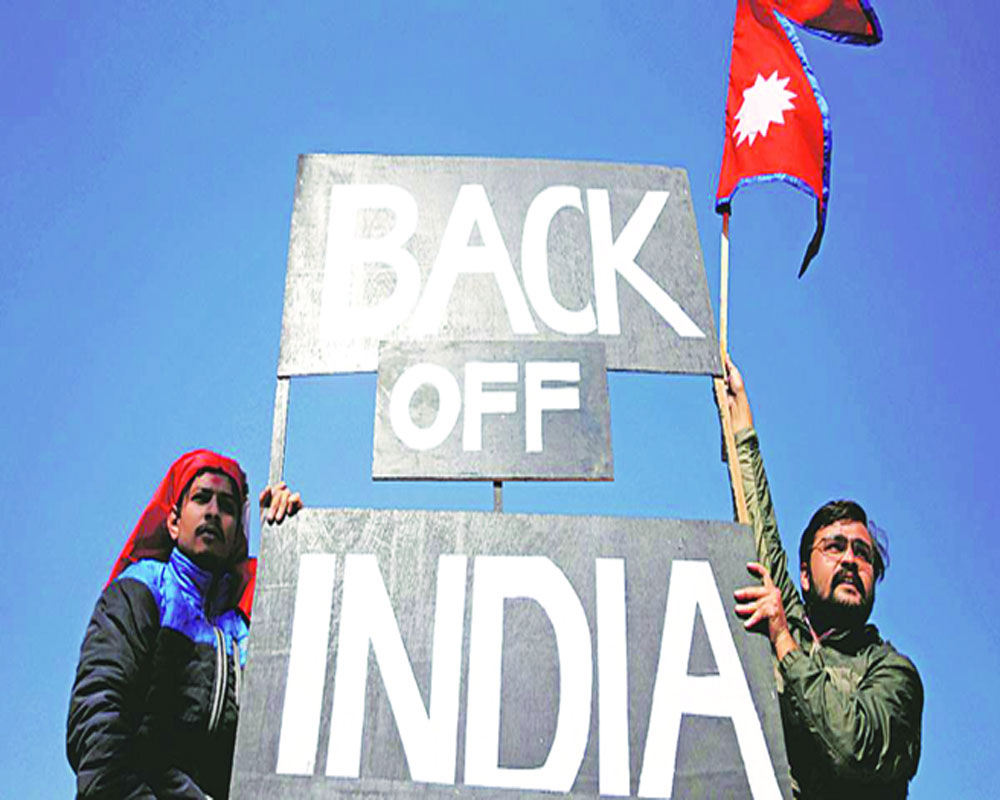The undue haste in passing a resolution on reclaiming old territories shows that China has it in its iron grip
Just when there are optics of both India and China simmering down tension in Ladakh, Nepal has reignited another Himalayan border dispute by approving a new map, including areas disputed with India, and rushing it through both Houses of Parliament. It is known that China doesn’t miss an opportunity to use India’s immediate neighbours as proxies whenever it doesn’t get what it wants from Delhi or doesn’t want to be seen as the trouble-maker. But coming so soon after Ladakh, Nepal’s aggression on the cartographic war, being waged around different interpretations of British era maps, shows that the dragon is still restive and is throwing full weight behind Nepal. It all began with the inauguration of an Indian road link that’s intended to smoothen pilgrim flow to Kailash Mansarovar near the Lipulekh pass on May 8. Nepali Prime Minister KP Oli claimed India was overstepping territorial sovereignty issues, albeit knowing about the construction for a long time. Though there is a long history of both nations making claims and counterclaims over this area, according to a 1954 treaty signed between them and China, Lipulekh Pass is very much an Indian gateway. The new road is now one of the quickest links between Delhi and the Tibetan plateau. However, China, too, recognised India’s sovereignty in 2015 by agreeing to expand trade through the pass. But overriding such precedents, Nepal released a revised political and administrative map showing Limpiyadhura, Lipulekh and Kalapani under its territory despite India releasing a precise map of the area last year. Now Nepal wants these territories back, with no political party opposing the resolution for reclamation. Yet India has been in possession of this territory for at least 60 years and has never been contested so before. Even the new road to Lipulekh does not challenge that status quo as it has built other infrastructure here before and deployed military forces up to the border with China. For argument’s sake, Nepal now claims it conducted a census there in the early 1950s and cites the 1815 Sugauli Treaty as legitimising its claims. It even says that the basis for demarcation, the Kali river, originates from a stream at Limpiyadhura, north-west of Lipulekh. Thus Kalapani, Limpiyadhura and Lipulekh are actually on its eastern bank and qualify to be part of Nepal’s Dharchula district. New Delhi has countered this saying that Kali originates in springs well below the pass, and that while the treaty does not demarcate the area north of these springs, administrative and revenue records of the 19th century show that Kalapani was on the Indian side and should be a part of Pithoragarh district in Uttarakhand. Not that the dispute hasn’t come up at diplomatic level talks and even in 2019, when India put out its new political map to show the changed status of Jammu and Kashmir. But China, as in Doklam, has taken advantage of the trijunction area to complicate the territorial confusion and push India backward. In much the same manner as it had done in Ladakh.
But if Nepal has gone so maximalist and nationalist, despite sharing Hindu origins and, therefore, more naturally inclined to the Narendra Modi regime, it means that China now has a complete grip on it. India’s relations with its immediate neighbours have in recent times been uneasy primarily because of two factors. One, the Chinese economic suzerainty in smaller nations through a colonising project of debt-trapping and infrastructure-building called the Belt and Road Initiative. Second, India’s over-dependence on historical, spiritual and geographical connect as a leitmotif of diplomacy rather than nurturing bilateral relations on more favourable and equal terms or defusing anxieties that smaller nations are bound to feel. Besides, China has now started frequently engaging with the political leadership of our neighbouring countries and as the Maldives experience shows, no political alignment is possible without China being in the picture. India misread Oli’s weakening position within the Nepal Communist Party (NCP) recently, when he faced a challenge from senior party leaders and former Prime Ministers Pushpa Kamal Dahal “Prachanda” and Madhav Kumar. It, therefore, rushed with the inaugural of the road, hoping to see him go and prop up a friendly candidate in power. Yet, China swiftly stepped in and mediated between all three rivals. The economic largesse of China has meant that each nation, while playing lip service to historical ties with India, is working with Beijing for mutual benefit. India should have seen this coming and been prepared. China will increasingly use Nepal as a pawn as it has Pakistan all this time. India ought to invest itself politically and economically in Nepal by taking it seriously as a partner and not as a servile State. Over 90 per cent of foreign direct investment (FDI) in Nepal is from China. Be it infrastructure or hydropower projects, everything is running on the yuan. Nepal’s growing trade deficit with China means that it will have no option but to become an economic serf, listening to the dictates of the new master. We need to settle this issue with pragmatism and speed so that China does not get the upper hand so easily.
























